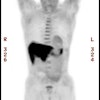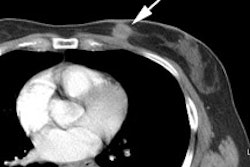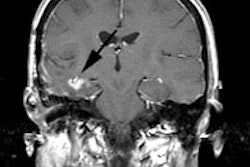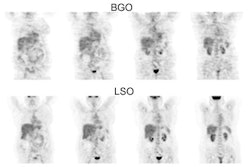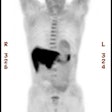J Clin Oncol 1998 Feb;16(2):603-9
18-F-fluorodeoxyglucose-positron emission tomography as a new approach to
detect lymphomatous bone marrow.
Moog F, Bangerter M, Kotzerke J, Guhlmann A, Frickhofen N, Reske SN.
PURPOSE: Bone marrow involvement in patients with malignant lymphoma is
considered a sign of generalized disease with less favorable prognosis. Bone
marrow biopsy (BMB), which represents the standard diagnostic procedure,
however, is associated with a high rate of false-negative findings, which may
lead to errors in management. The present study was undertaken to investigate
the efficacy of positron emission tomography (PET) with 18-F-fluorodeoxyglucose
(FDG-PET) as a new method to evaluate bone marrow involvement in patients with
malignant lymphoma. METHODS: Seventy-eight consecutive, untreated patients with
either non-Hodgkin's lymphoma (NHL; n = 39) or Hodgkin's disease (HD; n = 39)
were prospectively evaluated. Static FDG-PET imaging was performed following
application of 270 MBq (F-18)-FDG. Attenuation correction was performed in 63 of
78 patients. Visual evaluation was performed by two examiners unaware of the
clinical data. Material for BMB (70 bilateral, 8 unilateral) was obtained from
the posterior iliac crest. Discordant results of PET and biopsy were settled,
when possible, on the basis of further biopsy or magnetic resonance imaging (MRI).
RESULTS: In addition to seven concordant positive and 57 concordant negative
findings, biopsy revealed another four cases with bone marrow involvement not
detectable by FDG-PET analysis (+5.1%). On the contrary, PET showed bone marrow
areas of intensive FDG uptake that suggested bone marrow lymphoma in 10 patients
with negative biopsies (+12.8%). In eight patients, FDG-PET findings were
confirmed by either histologic verification (n = 4), MRI (n = 2), polymerase
chain reaction (PCR) for rearranged immunoglobulin H sequences (n = 1), or
clinical presentation (n = 1). Two cases remained unresolved. CONCLUSION: The
results indicate that FDG-PET has a high potential to detect bone marrow
involvement in malignant lymphoma. Besides confirming lesions found at BMB, FDG-PET
provided additional information, which, in eight of 78 patients (10.3%), led to
an upgrade of the tumor stage.

